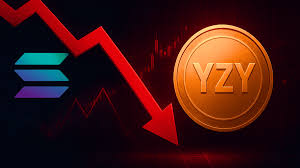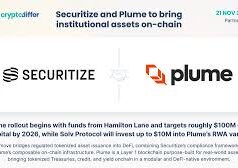Kanye West, now known as Ye, has never shied away from making waves, whether in music, fashion, or culture. On August 21, 2025, he dove headfirst into the cryptocurrency world with the launch of the YZY token on the Solana blockchain, sparking a frenzy that briefly propelled the token to a $3.2 billion market capitalization within 40 minutes. Marketed as the cornerstone of a “new economy” under the YZY Money ecosystem, the token promised to power transactions for Ye Pay, a crypto payment processor, and the YZY Card, a global spending tool. But the hype was short-lived. Within hours, the token crashed, losing over 60% of its value, leaving retail investors reeling and igniting accusations of insider trading, market manipulation, and a potential rug pull. Let’s unpack the messy launch, Kanye’s role, the fallout, and what it means for the crypto space.
The Hype Machine: Kanye’s Vision for YZY Money
Ye announced the YZY token via his X account, boasting 33.1 million followers, with a post proclaiming, “YEEZY MONEY IS HERE. A NEW ECONOMY, BUILT ON CHAIN.” The accompanying website outlined an ambitious vision: a decentralized financial ecosystem where YZY serves as the native currency for Ye Pay, a payment processor undercutting traditional card networks’ 3.5% fees, and the YZY Card, a debit card for spending YZY and USDC globally. The token was also pitched as a payment method for Yeezy brand merchandise, bypassing mainstream platforms like Shopify, which severed ties with Ye over his controversial statements. The tokenomics allocated 20% to the public, 10% to liquidity, and 70% to Yeezy Investments LLC, locked for 24 months with staged vesting.
This wasn’t Ye’s first brush with crypto. In February 2025, he publicly rejected a $2 million offer to promote a scam token, denouncing celebrity coins as “hype-driven scams that prey on fans.” His sudden pivot to launching YZY raised eyebrows, especially given the token’s centralized structure, with Ye reportedly holding 70% of the supply. Critics, including Coinbase director Conor Grogan, flagged that 94% of tokens were insider-controlled, with one multisig wallet initially holding 87% before distribution. This concentration set the stage for the chaos that followed.
A Meteoric Rise and Catastrophic Fall
The YZY token’s launch was nothing short of explosive. Within 40 minutes, it surged 6,800% to $3.16, hitting a $3.2 billion market cap, briefly ranking among the top 35 tokens. Trading volume spiked to $487 million in 24 hours, with the YZY/USDC pair on Meteora, a Solana-based decentralized exchange (DEX), recording $218 million alone. The token was quickly listed on major platforms, including CoinMarketCap, Bitget, Poloniex, and Binance’s Alpha platform, which requires 238 Alpha Points for participation. This institutional backing fueled speculation, drawing comparisons to Donald Trump’s TRUMP memecoin, which quadrupled from $4 billion to $15 billion in 28 hours.
But the rally collapsed as quickly as it began. By the end of August 21, YZY plummeted to $0.99, a 61% drop, with its market cap shrinking to $298 million. Some reports pegged losses as high as 95%, with the token trading at $0.15 in later sessions. The crash mirrored other celebrity token fiascos, like Argentina’s LIBRA, which tanked after President Javier Milei deleted a promotional post, and Kim Kardashian’s EthereumMax, fined by the SEC for undisclosed payments. The volatility underscored the speculative fever gripping Solana’s memecoin market, where hype often outpaces fundamentals.
Insider Trading Allegations: A Stacked Deck
The YZY launch was riddled with red flags, chief among them accusations of insider trading. Blockchain analytics firm Lookonchain revealed that multiple wallets with advance knowledge of the official contract address scooped up tokens at dirt-cheap prices. One wallet, 6MNWV8, spent 450,611 USDC to buy 1.29 million YZY at $0.35, later selling 1.04 million tokens for 1.39 million USDC, pocketing over $1.5 million in hours. Another insider used two wallets to buy 1.89 million YZY at $0.24, selling 1.59 million for 3.37 million USDC at $2.12, netting $3.4 million. To secure priority, one trader paid $24,000 in Solana fees. On-chain data showed the top six wallets controlled nearly 90% of the supply, with the top four holding 80%.1,2,3
The token’s liquidity pool design exacerbated these concerns. Unlike typical DEX pools pairing tokens with stablecoins like USDC, YZY’s pool was single-sided, seeded only with YZY tokens. This allowed developers or insiders to manipulate liquidity by adding or removing USDC at will, enabling price spikes and dumps. Lookonchain compared this to the LIBRA token’s collapse, noting that such structures leave retail investors vulnerable. TokenSniffer, a scam-detection tool, scored YZY a dismal 5/100, citing the top 10 holders’ control over a “substantial” share, which could crash prices if sold.1,2
Contract Address Chaos: A Costly Mistake
To deter bot-driven front-running, the YZY team deployed 25 decoy contract addresses, randomly selecting one as the official token. This “shell game” aimed to level the playing field but backfired spectacularly. Insiders evidently knew the correct address, negating the anti-sniping mechanism, while retail traders were left guessing. One user mistakenly bought a decoy token, losing $710,000, though they later recouped losses by purchasing the correct YZY. Another trader spent $767,000 on a wrong address, cutting losses at $704,000 within three hours. The confusion amplified the launch’s chaos, with retail investors bearing the brunt of the misstep.
The contract address debacle wasn’t just a technical hiccup—it exposed deeper issues with transparency. On-chain analyst Ai Yi noted that insider wallet 6MNWV8 attempted to buy YZY a day before the launch, suggesting privileged access. The lack of clear communication about the official address, coupled with the concentrated token supply, fueled suspicions that the launch was designed to favor insiders over retail participants.
Losses and Lamentations: Retail Investors Left Holding the Bag
While insiders cashed out millions, retail traders faced devastating losses. One wallet spent 1.55 million USDC to buy 996,453 YZY at $1.56, only to sell at $1.06, losing $500,000 in under two hours. Another trader on Hyperliquid, a DEX offering 3x leverage, lost $160,000 longing YZY before doubling down despite the crash. The token’s 37,000% volume surge masked a brutal reality: late entrants chasing the hype were often wiped out. Social media buzz, amplified by influencers like James Wynn and accounts like @Edwardbayc, promised massive profits, but X-Alpha data showed much of it was engagement farming, not organic interest.
The YZY website’s fine print didn’t help, warning of “potential for complete loss” and including a class-action waiver, barring investors from collective lawsuits. This mirrored the TRUMP token’s terms, raising fears that YZY was structured to shield Ye and his team from legal fallout. The parallels to LIBRA’s collapse, where a U.S. judge unfroze $57.6 million in USDC tied to a rug pull, further stoked rug-pull fears. Some speculated that LIBRA’s founder, Hayden Davis, might be linked to YZY, though no evidence confirmed this.
BitMEX Co-Founder’s Regret: A High-Profile Misstep
BitMEX co-founder Arthur Hayes was among the high-profile investors caught in the YZY frenzy. Initially, he posted on X, “Pls don’t rug me @kanyewest!!! $YZY for the win … cause bull market,” signaling optimism despite suspecting a potential rug pull. Hours later, as prices tanked, Hayes backtracked, writing, “Oopsie … fam next time pls don’t let me trade shitters like $YZY. Should have just kept two-steppin.” His candid regret highlighted the token’s volatility and the risks even seasoned traders faced. Hayes’ involvement, alongside leverage trader James Wynn, who cited TRUMP’s success as a reason to buy YZY on a 60% dip, underscored the speculative allure of celebrity tokens, even amid red flags.
Kanye’s Role: Hype Man or Mastermind?
Ye’s involvement was central to YZY’s meteoric rise and fall. His X posts, including a video confirming the launch, drove the initial surge, leveraging his cultural influence and massive following. The YZY Money website, branded with his Yeezy aesthetic, positioned him as the face of the project, though it’s unclear how hands-on he was. Reports suggest Yeezy Investments LLC, tied to Ye, controls 70% of the token supply, raising questions about his financial motives, especially given his estimated $400 million net worth. His earlier rejection of a $2 million scam token offer added irony, as YZY’s insider-heavy structure drew similar criticisms. Some speculated his account was hacked or the video was an AI deepfake, but a follow-up post showing Ye in person quelled those doubts.
Ye’s pivot from crypto skeptic to token issuer baffled the community. In February, he claimed, “I only make products. I am already very wealthy and have no need to do other things.” Yet, the YZY launch, delayed from February due to LIBRA’s scandal, suggested a strategic move to capitalize on the celebrity memecoin craze, possibly inspired by TRUMP’s success. The timing, just after a U.S. judge unfroze LIBRA’s assets, hinted at a calculated bet on market hype, but the insider allegations and crash tarnished Ye’s credibility.
Regulatory Shadows and Ecosystem Promises
The YZY launch reignited debates about celebrity-driven crypto projects. The SEC’s 2023 fine against Kim Kardashian for EthereumMax and lawsuits against Floyd Mayweather and Paul Pierce signal growing regulatory scrutiny. YZY’s centralized structure, insider profits, and class-action waiver align with patterns the SEC has targeted, raising the specter of legal action. The token’s liquidity pool and 94% insider control also sparked “pump-and-dump” accusations, with TokenSniffer’s 5/100 score labeling it a high-risk asset.
Despite the turmoil, the YZY Money ecosystem promises innovation. Ye Pay aims to offer merchants lower fees, while the YZY Card could bridge crypto and fiat spending. If executed, these could legitimize YZY beyond a memecoin, but no working products have materialized, and the website’s vague claims fueled skepticism. Solana itself benefited, rising 2% amid the trading frenzy, but the network’s history of memecoin volatility—evident in LIBRA and TRUMP—underscored systemic risks.
Exchanges and Market Dynamics
YZY’s rapid listing on CoinMarketCap, Bitget, Poloniex, and Binance Alpha lent it credibility, but also amplified volatility. Binance’s Alpha platform, targeting early-stage projects, signaled institutional interest, while Meteora’s $120 million liquidity pool (down from $200 million) and $9.85 million in fees highlighted intense DEX activity. Hyperliquid’s 3x leverage YZY/USDC contract further fueled speculation, though high fees (4-5% implicit) deterred some traders. The listings, while boosting visibility, didn’t prevent the crash, as insider sales and liquidity manipulation overwhelmed retail enthusiasm.
The Bigger Picture: Celebrity Crypto’s Double-Edged Sword
The YZY saga encapsulates the allure and peril of celebrity-backed tokens. Ye’s star power drove unprecedented hype, but the insider-heavy launch, flawed liquidity design, and contract address confusion left retail investors exposed. Losses like $500,000 and $710,000 underscored the risks, while insider profits of $1.5 million to $6 million highlighted an uneven playing field. The crash, from $3.2 billion to $137 million in hours, mirrored past failures like LIBRA and EthereumMax, raising questions about transparency and regulation.
Yet, YZY’s ambition to build a decentralized payment system tied to Yeezy’s brand hints at potential, if trust can be restored. For now, it’s a cautionary tale of hype outpacing substance, with retail traders paying the price. As one X user put it, “$YZY launch by kanyewest … price manipulation possible, no doubt.” The crypto community is left wondering: Is YZY a bold experiment or another celebrity cash grab? Only time will tell, but the scars of its launch will linger.
Sources:
- Cointelegraph: Kanye West Launches YZY Memecoin, Which Rises Then Falls
- CoinCentral: Kanye’s Crypto Token Crashes After Insiders Cash Out Millions
- InsideBitcoins: YZY MONEY Meme Coin Linked To Kanye West Crashes 55%
- BitcoinEthereumNews: Kanye West Launches YZY Token on Solana, Sparks Insider Trading Controversy
- Coinpedia: Crypto Rugpull? Arthur Hayes Calls Out Kanye’s $YZY Token After Costly Gamble
- Blockonomi: Kanye West’s YZY Token Reaches $3 Billion Market Cap Before Quick Decline
- BitcoinEthereumNews: Kanye’s YZY Launch Rockets Into Top 35 Tokens Then Crashes 95%
- Gate.com: Read ALL About YZY in One Article
- AInvest: Kanye’s YZY Soars on Binance, Sparking a Battle for Crypto Culture
- Yahoo Finance: Kanye Tweets ‘Yeezy Money is Here’ as YZY Token Crashes 70%
- CCN: Kanye West Unveils YZY Token Amid Insider Trading and Rug Pull Rumors
- X Post by @kanyewest, August 21, 2025
- X Post by @lourdesanchezok, August 21, 2025




























Kanye’s YZY was supposed to be a “new economy,” but 94% insider control?
I have never liked this guy for any reason whatsoever. He’s now the “richest” artist on the planet.
That 70% to his LLC screams pump-and-dump.
Crypto noob here—what’s up with Kanye’s YZY crashing like that?
what’s up with Kanye’s YZY crashing like that?
YZY’s $3B spike and 90% crash, hmmm
Insider trading and a $3B-to-$1B drop sounds like a scam.
Kanye’s “anti-sniping” 25 contracts didn’t stop insiders from banking millions.
$1.5M profits for one wallet? Shady AF. Think Ye Pay’s legit, or just hype?
Solid article, but I’m steering clear of this one!
YZY’s launch was pure chaos!